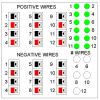I'm trying to design a "tester" for checking continuity of "through wires" in an electric hinge we make. The hinge will be mounted to a swing test stand and cycled repeatedly to test the integrity of the wires. The wires in the hinge are about 24 or 26 AWG. I am using a 2191U5-24V LED indicator lamp (Chicago Miniautre Lighting - Newark PN# 88M9621) to see that the wire is "good". On one side of the hinge (wire) I am connecting to +24VDC through the use of a power supply. The other side of the hinge (wire) connects to the RED lead on the LED, and finally the WHITE lead is connected to -24VDC. No problem.
However, I need to connect as many as 12 wires for a total of 12 LED's and I need to power up a 24VDC Ice Cube relay (for breaking the "enable" on the motor for the hinge swinger). It's been a long time since I was in electronics school, but it didn't take me long to remember VOLTAGE DROP. With only 1 (one) LED connected in series to the positve for the coil on the relay, I don't have enough to pull the relay in. I have only 6VDC. I've tried connecting the lights in series and in parallel, but still don't end up with enough voltage to pull in the relay. A PLC would solve the problem easily enough, but I was hoping to save cost. Does anyone have any suggestions?
However, I need to connect as many as 12 wires for a total of 12 LED's and I need to power up a 24VDC Ice Cube relay (for breaking the "enable" on the motor for the hinge swinger). It's been a long time since I was in electronics school, but it didn't take me long to remember VOLTAGE DROP. With only 1 (one) LED connected in series to the positve for the coil on the relay, I don't have enough to pull the relay in. I have only 6VDC. I've tried connecting the lights in series and in parallel, but still don't end up with enough voltage to pull in the relay. A PLC would solve the problem easily enough, but I was hoping to save cost. Does anyone have any suggestions?




